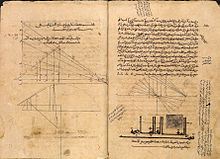Apollonius of Perga
Apollonius of Perge or Perga (Greek Ἀπολλώνιος) (Perge, c. 262 BC - Alexandria, c. 190 BC) was a Greek mathematician and astronomer famous for his work On Conic Sections. He was the one who gave the name of ellipse, parabola and hyperbola, to the figures we know. He managed to solve the general quadratic equation by means of conical geometry.
He is also credited with the hypothesis of eccentric orbits or epicycle theory to try to explain the apparent movement of the planets and the variable speed of the Moon.
His extensive works on geometry deal with conic sections and plane curves and the squaring of their areas. He compiled his work in eight books and was known by the nickname The Great Geometer.
Biography
He was born around 262 B.C. in the city of Perge or Perga (Turkey) and died around 190 B.C. in Alexandria, Egypt.
It is known that he stayed in the city of Perga during the reigns of Ptolemy Evergetes and Ptolemy Philopator, while he was general treasurer of Ptolemy Philadelphus. From the sources it can be affirmed that he was between twenty-five and forty years younger than Archimedes, hence the estimate of the years of his birth and death. Other than that, the little that is known about his life is that he studied in Alexandria and in this city he dedicated himself to teaching.
Work
He studied the conic sections using proportions as a tool, relating the magnitudes of each element that make up each conic section in the case of the parabola, ellipse and hyperbola where he used this method to define the properties of each cut with the cone, such as It is demonstrated by Heath (1896), he also proposed and solved the problem of finding the tangent circles to three given circles, known as the Apollonius problem. The problem appears in his work, now lost, The Tangencies or The Contacts , known thanks to Pappus of Alexandria. Regarding his works, many have been lost:
- Fast delivery (rápidoκυτόκιον), in which rapid calculation methods were taught and an approximation of the π number was given.
- Sections in a given reason (のόγου φποτομυ, De Rationis Sectione) dealt with the problems arising from drawing a straight that passes by a given point and that cuts two other straights given in segments (measured from sendos points located in those lines) that are in a given reason (this problem is equivalent to solving the equationax− − x2=bc{displaystyle ax-x^{2}=bc}).
- Sections in a given area (EUR) De Spatii Sectione), problem similar to the previous one, but now it is requested that the segments determined by the intersections form a rectangle equivalent to another (this problem is equivalent to solving the equationax+x2=bc{displaystyle ax+x^{2}=bc}).
- Specific sections (Διωρισμ De Sectione Determinata), given four points A, B, C, D, on a straight, find a fifth point P, such that the rectangle built on AP and CP is in a given reason with the rectangle built on BP and DP.
- Tangencias (,παφαί, De Tactionibus), solves the problems of building a tangent circumference to any three elements chosen between a point, a straight and a circumference (this problem is known as the problem of Apollonius).
- Flat places (Τόποι /25070/ίπεδοι, Locis Planis), the Greeks classified the curves in three types: flat places, were the straight and the circumferences, solid places were the conical sections and linear places the rest of the curves; Inclinations, it was the problem of drawing a circle given a string of length given passing by a given point.
Only two works by Apollonius have survived to this day: Sections in a given reason (the original is not preserved but a translation into Arabic) and The Conics (only The original of half of the work is preserved, the rest is a translation into Arabic). The latter is the most important work of Apollonius, indeed, together with Euclid's Elements it is one of the most important books on mathematics.
Las Cónicas consists of 8 books. It was written when Apollonius was in Alexandria but later, already in Pergamum (now Bergama in Turkey), he improved it.
- Book I: deals with the fundamental properties of these curves.
- Book II deals with the conjugated diameters and tangents of these curves.
- Book III: deals with the types of cones.
- Book IV: deals with the ways in which the cone sections can be cut.
- Book V: studies maximum and minimum segments drawn with respect to a conic.
- Book VI: deals with similar conics.
- Book VII: deals with conjugated diameters.
- Book VIII: It has been lost, it is believed to be an appendix.
The methods used by Apollonius (use of straight lines as reference systems) are very similar to those used by Descartes in his Geometry and are considered an anticipation of current analytical Geometry. In fact, he already used rectangular coordinates. With the help of these, Apollonius defined curves that were well known in his time: the parabola, the hyperbola and the ellipse by means of the equations:
- and2=p⋅ ⋅ x{displaystyle and^{2}=pcdot x} (gun)
- and2=p⋅ ⋅ x+pa⋅ ⋅ x2{displaystyle and^{2}=pcdot x+{cfrac {p}{a}{cdot x^{2}}}} (sighs)
- and2=p⋅ ⋅ x− − pa⋅ ⋅ x2{displaystyle and^{2}=pcdot x-{cfrac {p}{a}{cdot x^{2}}}} (elipse)
- where p and a They're positive numbers.
Acknowledgments
- Moon crater Apollonius bears this name in his memory.
Contenido relacionado
Homomorphism
Five
United Nations Industrial Development Organization







